Affordable gamer. With its LOQ series, Lenovo tries out a new name for affordable gaming laptops compared to the more expensive Legion models. The current 16-inch model is affordable, and the performance is right. So where is the hitch? We test the gaming laptop with an RTX 4060!
Christian Hintze, 👁 Christian Hintze (translated by Mark Riege), Published 09/30/2023 🇩🇪
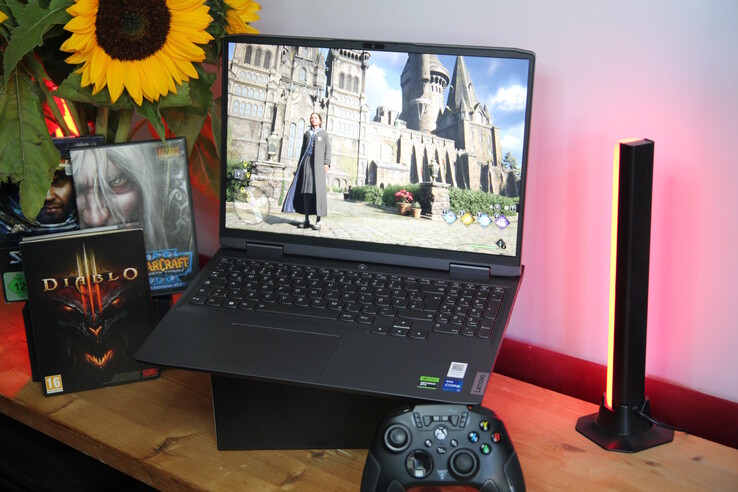
With the new LOQ series, Lenovo offers especially affordable gaming laptops that replace the IdeaPad Gaming series of prior years. We were already able to test the 15-inch LOQ 15 with an AMD processor and are now taking a look at the slightly larger LOQ 16 with an Intel CPU, 16 inch display, and 16:10 form factor. How does the laptop fare against the competitors, and are gamers getting a real bargain here?
We basically go one category higher than with the LOQ 15 here, since instead of an RTX 4050, our test model uses an RTX 4060, instead of only 8 GB of RAM, there are 16 GB, and instead of the Full-HD display, we now get QHD.
The competitors include other budget gaming laptops with a similar graphics card, such as the Dell Inspiron 16 Plus 7630, the Acer Nitro 16 AN16-41 (unfortunately only with an RTX 4050), and also the Captiva Advanced Gaming I74-121. Things get slightly more expensive with the Legion Slim 5 16APH8 inhouse competitor and the Asus TUF Gaming A16 Advantage Edition FA617XS.
Processor
Intel Core i7-13620H 10 x 1.8 – 4.9 GHz, 65 W PL2 / Short Burst, 35 W PL1 / Sustained, Raptor Lake-H
Memory
16 GB
, 2x 8 GB SK Hynix DDR5-5600
Display
16.00 inch 16:10, 2560 x 1600 pixel 189 PPI, AUOC1A5 (B160QAN03.L), IPS, glossy: no, 165 Hz
Mainboard
Intel Alder Lake-P PCH
Soundcard
Intel Raptor Lake-P/U/H PCH – cAVS
Connections
1 USB 3.0 / 3.1 Gen1, 2 USB 3.1 Gen2, USB-C Power Delivery (PD), 1 HDMI, 1 DisplayPort, Audio Connections: combined headphone/microphone port
Networking
Realtek RTL8168/8111 Gigabit-LAN (10/100/1000MBit/s), Bluetooth Bluetooth 5.1
Size
height x width x depth (in mm): 25.9 x 359.6 x 277.6 (=1.02 x 14.16 x 10.93 in)
Operating System
Microsoft Windows 11 Home
Camera
Webcam: 1080p FHD camera with e-shutter
Primary Camera: 2 MPix
Additional features
Speakers: 2x2W speaker system with Nahimic Audio, Keyboard: Chiclet, Keyboard Light: yes, 12 Months Warranty
Weight
2.655 kg (= 93.65 oz / 5.85 pounds), Power Supply: 867 g (= 30.58 oz / 1.91 pounds)
Note: The manufacturer may use components from different suppliers including display panels, drives or memory sticks with similar specifications.
The Lenovo LOQ series looks more bulky and massive than the more expensive Legion series. This is not least due to the cooling system protruding in the back that reminds us of the Alienware models. The back fan vent also holds the only colorful accents that stand out in bright blue from the otherwise gray design. The front edge is slightly rounded, and the top shows the Lenovo and LOQ logos. The surfaces are kept very smooth, and there are no metal elements like in the Legion.
While the laptop can be opened easily with a single hand up to a maximum opening angle of 160 degrees, the two hinges still hold the display in place fairly well. The palm rests and keyboard surface consist of a single plate with the latter being minimally lowered.
Even though the base produces a few creaking noises when we try to warp it, everything is still sufficiently robust overall. The workmanship is decent, and we do not notice any larger gaps between the materials.
In our comparison, the LOQ 16 is one of the largest and particularly also heaviest 16-inch devices. Due to the cooling system protruding in the back, the laptop is much deeper than most of the competitors. Only the Acer Nitro 16 has a similar size, but it still weighs 100 gram (~3.5 oz) less than our LOQ test unit. All the other models are lighter than that.
Captiva Advanced Gaming I74-121 Acer Nitro 16 AN16-41-R7YE Lenovo LOQ 16IRH8 Lenovo Legion Slim 5 16APH8 Asus TUF Gaming A16 FA617XS Dell Inspiron 16 Plus 7630 DIN A4 ❌
361 mm / 14.2 inch
241 mm / 9.49 inch
29 mm / 1.142 inch
2.3 kg5.08 lbs360.1 mm / 14.2 inch
279.9 mm / 11 inch
27.9 mm / 1.098 inch
2.6 kg5.64 lbs359.6 mm / 14.2 inch
277.6 mm / 10.9 inch
25.9 mm / 1.02 inch
2.7 kg5.85 lbs359.7 mm / 14.2 inch
260.3 mm / 10.2 inch
25.2 mm / 0.992 inch
2.4 kg5.2 lbs355 mm / 14 inch
252 mm / 9.92 inch
22.1 mm / 0.87 inch
2.2 kg4.81 lbs356.78 mm / 14 inch
251.9 mm / 9.92 inch
19.95 mm / 0.785 inch
2.2 kg4.8 lbs297 mm / 11.7 inch
210 mm / 8.27 inch
1 mm / 0.03937 inch
5.7 g0.01257 lbs
In terms of connection equipment, the budget gaming laptop only offers the most necessary. You get a total of four USB ports with three of them running at 10 Gbit/s. Although there is a single USB-C port, it lacks Thunderbolt. We also look in vain for an SD card reader.
We like the placement of the ports that are positioned on three sides, offering sufficient space in between. Most of the ports are in the back, with only two ports on the left and a single port on the right leaving plenty of space for the mouse hand.
Even though the Intel AX203 module delivers Wi-Fi 6, its speed is surpassed by the AX211 used by most of the competitors. It is also unable to connect to the 6-GHz network.
While the transfer rates are constant, at around 800 MB/s, they remain behind those of the competitors, which often reach more than 1 GB/s.
Lenovo Legion Slim 5 16APH8
MediaTek Wi-Fi 6E MT7922 160MHz Wireless LAN Card
1557 (1481min – 1700max) MBit/s ∼100% +103%
Acer Nitro 16 AN16-41-R7YE
MediaTek Wi-Fi 6E MT7922 160MHz Wireless LAN Card
1491 (1391min – 1562max) MBit/s ∼96% +94%
Average of class Gaming
(714 – 1780, n=118, last 2 years)
1326 MBit/s ∼85% +73%
Dell Inspiron 16 Plus 7630
Intel Wi-Fi 6E AX211
1261 (1137min – 1385max) MBit/s ∼81% +64%
Global Average -3
(36.6 – 1861, n=620)
964 MBit/s ∼62% +26%
Captiva Advanced Gaming I74-121
Intel Wi-Fi 6E AX211
862 (812min – 927max) MBit/s ∼55% +12%
Asus TUF Gaming A16 FA617XS
Realtek RTL8852BE
776 (392min – 802max) MBit/s ∼50% +1%
Lenovo LOQ 16IRH8
768 (712min – 807max) MBit/s ∼49%
Acer Nitro 16 AN16-41-R7YE
MediaTek Wi-Fi 6E MT7922 160MHz Wireless LAN Card
1685 (1180min – 1751max) MBit/s ∼100% +100%
Lenovo Legion Slim 5 16APH8
MediaTek Wi-Fi 6E MT7922 160MHz Wireless LAN Card
1471 (1302min – 1560max) MBit/s ∼87% +74%
Average of class Gaming
(685 – 1890, n=125, last 2 years)
1424 MBit/s ∼85% +69%
Dell Inspiron 16 Plus 7630
Intel Wi-Fi 6E AX211
1184 (1047min – 1237max) MBit/s ∼70% +40%
Global Average -3
(34.8 – 1890, n=631)
1021 MBit/s ∼61% +21%
Captiva Advanced Gaming I74-121
Intel Wi-Fi 6E AX211
925 (909min – 935max) MBit/s ∼55% +10%
Asus TUF Gaming A16 FA617XS
Realtek RTL8852BE
905 (765min – 969max) MBit/s ∼54% +7%
Lenovo LOQ 16IRH8
843 (426min – 854max) MBit/s ∼50%
Lenovo Legion Slim 5 16APH8
MediaTek Wi-Fi 6E MT7922 160MHz Wireless LAN Card
1674 (1578min – 1812max) MBit/s ∼100%
Dell Inspiron 16 Plus 7630
Intel Wi-Fi 6E AX211
1524 (1318min – 1580max) MBit/s ∼91%
Captiva Advanced Gaming I74-121
Intel Wi-Fi 6E AX211
1516 (149min – 1644max) MBit/s ∼91%
Average of class Gaming
(843 – 1878, n=59, last 2 years)
1514 MBit/s ∼90%
Global Average -3
(229 – 1894, n=294)
1392 MBit/s ∼83%
Captiva Advanced Gaming I74-121
Intel Wi-Fi 6E AX211
1590 (1563min – 1611max) MBit/s ∼100%
Average of class Gaming
(853 – 1857, n=61, last 2 years)
1527 MBit/s ∼96%
Global Average -3
(390 – 1857, n=295)
1434 MBit/s ∼90%
Lenovo Legion Slim 5 16APH8
MediaTek Wi-Fi 6E MT7922 160MHz Wireless LAN Card
1323 (1216min – 1388max) MBit/s ∼83%
Dell Inspiron 16 Plus 7630
Intel Wi-Fi 6E AX211
1229 (1099min – 1323max) MBit/s ∼77%
05010015020025030035040045050055060065070075080085090095010001050110011501200125013001350140014501500155016001650170017501800Tooltip
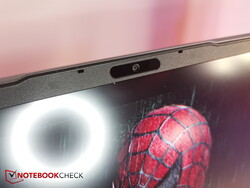 The webcam
The webcam
Lenovo has placed a Full-HD camera in the top edge of the display bezel. We appreciate the existence of an (electronic) privacy shutter on the right side.
The camera itself produces some fairly high color deviations, but it is still sufficient for making the occasional video call in good light conditions.
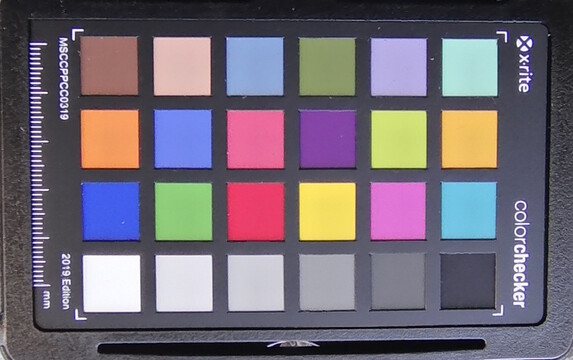
14.5 ∆E
11.9 ∆E
16 ∆E
18 ∆E
14.1 ∆E
13.7 ∆E
9.8 ∆E
19.5 ∆E
14.6 ∆E
12.2 ∆E
10.4 ∆E
8.7 ∆E
15.3 ∆E
17.4 ∆E
15.5 ∆E
7 ∆E
14.3 ∆E
20.3 ∆E
2.6 ∆E
7.8 ∆E
13.8 ∆E
17.2 ∆E
18.7 ∆E
13.2 ∆E
ColorChecker Lenovo LOQ 16IRH8: 13.61 ∆E min: 2.64 – max: 20.33 ∆E
TPM is of course included, although the LOQ lacks a fingerprint sensor or a Kensington lock.
Those who expect some accessories should look a few price classes higher. Except for the laptop itself and its charger, the box only includes some paperwork.
In Europe, Lenovo offers two years of warranty with courier pickup or shipping by the customer. At an additional cost, you can also purchase Lenovo Premium Care (Plus) with 24-hour customer support.
The cooling system protruding in the back makes removing the bottom of the case slightly more difficult than in other laptops. You first have to remove ten Philips screws. But be careful: The four screws in front are significantly shorter and set at an angle, so you should not make the mistake of trying to use one of the longer screws here.
Before you can remove the bottom plate, you first have to slide the cover of the protruding cooling system toward the back, since below that, the bottom plate is fastened with three additional screws. After removing those, you can pry open the bottom plate starting from the front without having to use any additional tools.
Inside, you get access to the fans, the battery, the Wi-Fi module, the two RAM slots that are covered by some foil, the SSD, and the second SSD slot. Interestingly, Lenovo uses a short SSD in the M.2 2230 form factor, even though there would be sufficient space for a regular-size M.2 2280 SSD and the screwing frame for it is also already there.
Despite having a new name, the LOQ quasi inherits the keyboard of the IdeaPad Gaming 3. The layout looks clean, with the arrow keys separated and moved toward the bottom, allowing them to have full size. A slim number pad is squeezed in on the right.
The regular keys have a good size and are rounded on their bottom edges. The key stroke isn’t particularly long, and the feedback could have been a bit tighter, although it is still okay. The keyboard allows for quick typing, but some users might find the stroke a bit soft. The typing noise is very moderate.
In dark surroundings, the white, two-level keyboard illumination helps, but there are no light effects, separate zones, or RGB.
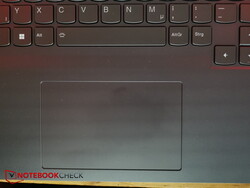 The touchpad
The touchpad
The touchpad has a good size with about 12 x 7.5 cm (~4.7 x 3 in). It offers good sliding characteristics for dry fingers, but movement of moist fingers can stutter easily.
The clicking areas integrated at the bottom are rather hard, with only a very short stroke. The feedback is still clear. Clicking noises are louder than typing, but still acceptable.
The matte 16:10 IPS display in our test unit comes from AU Optronics, offers a resolution of 2,560 x 1,600 pixels, and supports 165 Hz. However, you should still take a closer look before a purchase, since there is also an alternative version that offers only a 1,920 x 1,200 pixel resolution and 144 Hz refresh rate.
The brightness is 369 nits on average, but at 85%, the brightness distribution isn’t very even, and we measure more than 400 nits in the center.
Unfortunately, the black value is a bit high, preventing higher contrast values.
But overall, the display is decent. The response times are fairly fast, and PWM isn’t used for brightness control. Backlight bleeding also doesn’t appear to be a problem in our test unit.
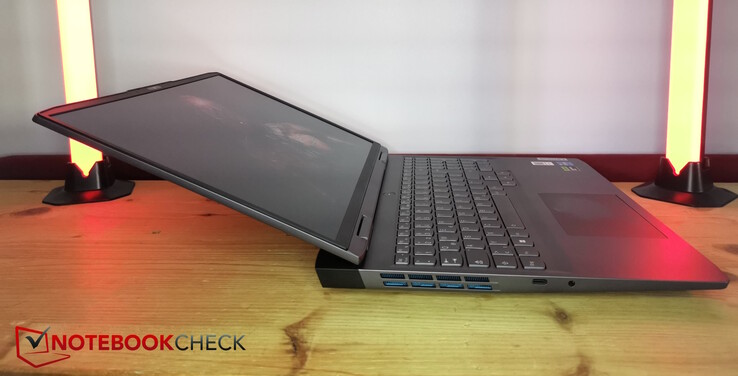 160 degree display opening angle
160 degree display opening angle
355
cd/m²365
cd/m²371
cd/m²364
cd/m²407
cd/m²372
cd/m²346
cd/m²382
cd/m²360
cd/m²
Distribution of brightness
AUOC1A5 (B160QAN03.L)
X-Rite i1Pro 3
Maximum: 407 cd/m² (Nits) Average: 369.1 cd/m²
Brightness Distribution: 85 %
Center on Battery: 407 cd/m²
Contrast: 904:1 (Black: 0.45 cd/m²)
ΔE Color 1.43 | 0.55-29.43 Ø5.1, calibrated: 1.07
ΔE Greyscale 1.13 | 0.57-98 Ø5.3
72.6% AdobeRGB 1998 (Argyll 2.2.0 3D)
98.9% sRGB (Argyll 2.2.0 3D)
70.5% Display P3 (Argyll 2.2.0 3D)
Gamma: 2.5
Lenovo LOQ 16IRH8
AUOC1A5 (B160QAN03.L), IPS, 2560×1600, 16.00Dell Inspiron 16 Plus 7630
LG Philips 160WQ2, IPS, 2560×1600, 16.00Acer Nitro 16 AN16-41-R7YE
AU Optronics B160UAN01.Q, IPS, 1920×1200, 16.00Captiva Advanced Gaming I74-121
BOE08B3, IPS, 1920×1080, 15.60Lenovo Legion Slim 5 16APH8
BOE NJ NE160QDM-NYC, IPS, 2560×1600, 16.00Asus TUF Gaming A16 FA617XS
BOE NE160WUM-NX2, IPS, 1920×1200, 16.00 Display P3 Coverage
70.5
70.1
-1%
80
13%
64
-9%
69.3
-2%
69.3
-2%
sRGB Coverage
98.9
99.6
1%
99.4
1%
93.2
-6%
100
1%
97.3
-2%
AdobeRGB 1998 Coverage
72.6
72.3
0%
77.4
7%
66
-9%
70
-4%
70.7
-3%
Response Time Grey 50% / Grey 80% *
7.2 ?(4, 3.2)
35 ?(15.7, 19.3)
-386%
11.2 ?(5.3, 5.9)
-56%
5 ?(2.422, 2.578)
31%
10.7 ?(5.2, 5.5)
-49%
15.6 ?(7.3, 8.3)
-117%
Response Time Black / White *
7.4 ?(3, 4.4)
24.2 ?(10.8, 13.4)
-227%
5.2 ?(1.9, 3.3)
30%
7.55 ?(3.7, 3.85)
-2%
7.8 ?(3.9, 3.9)
-5%
10 ?(5.7, 4.3)
-35%
PWM FrequencyBrightness middle
407
299.4
-26%
415
2%
346
-15%
371.6
-9%
301
-26%
Brightness
369
290
-21%
380
3%
324
-12%
343
-7%
294
-20%
Brightness Distribution
85
92
8%
84
-1%
90
6%
84
-1%
94
11%
Black Level *
0.45
0.21
53%
0.36
20%
0.35
22%
0.44
2%
0.21
53%
Contrast
904
1426
58%
1153
28%
989
9%
845
-7%
1433
59%
Colorchecker dE 2000 *
1.43
4.25
-197%
4.71
-229%
4.12
-188%
1.52
-6%
1.79
-25%
Colorchecker dE 2000 max. *
3.58
6.71
-87%
6.98
-95%
7.78
-117%
2.68
25%
3.48
3%
Colorchecker dE 2000 calibrated *
1.07
0.52
51%
2.68
-150%
1.22
-14%
0.33
69%
1.2
-12%
Greyscale dE 2000 *
1.13
5.5
-387%
3.6
-219%
4.81
-326%
1.2
-6%
2.5
-121%
Gamma
2.5 88%
2.35 94%
2.182 101%
2.31 95%
2.1 105%
2.265 97%
CCT
6526 100%
6368 102%
7153 91%
7633 85%
6503 100%
6157 106%
* … smaller is better
At least, the sRGB color space is covered almost completely. But AdobeRGB and DisplayP3 are covered to only 70%. While this makes the display of the LOQ 16 suitable for gaming for sure, it is also okay for the occasional, non-professional photo and video processing.
The display already offers a decent calibration in the state of delivery, and we measure only low deviations in the colors and grayscale. An additional calibration using our Xrite color measurement device and Calman software is able to slightly decrease the DeltaE deviations even further.
You can download our calibrated ICC color profile for free using the link above.
Display Response Times
ℹ
Display response times show how fast the screen is able to change from one color to the next. Slow response times can lead to afterimages and can cause moving objects to appear blurry (ghosting). Gamers of fast-paced 3D titles should pay special attention to fast response times.
Screen Flickering / PWM (Pulse-Width Modulation)
ℹ
To dim the screen, some notebooks will simply cycle the backlight on and off in rapid succession – a method called Pulse Width Modulation (PWM) . This cycling frequency should ideally be undetectable to the human eye. If said frequency is too low, users with sensitive eyes may experience strain or headaches or even notice the flickering altogether.
Screen flickering / PWM not detected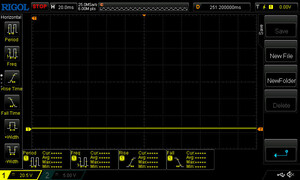
In comparison: 54 % of all tested devices do not use PWM to dim the display. If PWM was detected, an average of 18941 (minimum: 5 – maximum: 3846000) Hz was measured.
Due to the matte display surface and at least decent brightness, you can also see the display contents easily outdoors. What is required though, is a shady place and avoiding direct sunlight or very steep viewing angles.
 Good IPS typical viewing angle stability. Brightness only gets lost noticeably from extreme viewing angles.
Good IPS typical viewing angle stability. Brightness only gets lost noticeably from extreme viewing angles.
The Core i7-13620H in combination with an RTX 4060 identifies the device as a gaming laptop that should allow playing almost all the current games in at least Full-HD resolution and also at full detail settings. Even in the native QHD resolution, the laptop shouldn’t start losing its breath in many games. 16 GB of working memory are appropriate for an affordable gaming laptop.
However at 512 GB, the storage is a bit tight considering the immense space requirements of current AAA games, but fortunately you can upgrade here later.
The manufacturer of our test unit calls its control center Lenovo Vantage. Lenovo has overdone it here, since in addition to the important performance options and additional settings, the software includes a lot of advertisements. The ads not only include inhouse ads for warranty extensions, for other services such as “cloud-based security solutions,” and for insurance in case of water damage, damage from falls, and so forth, but also for software from third-party vendors such as Spotify, Amazon, YouTube, for the Legion Games Shop, for McAffee – the list goes on and on.
In addition, there are various preinstalled software apps such as Lenovo Arena, Lenovo Hotkeys, Lenovo Now, and trial versions of Office and McAffee, and so forth.
With all this unnecessary stuff, you almost forget that the manufacturer of course uses the control center software to offer the obligatory performance settings and other important options to justify its existence. The LOQ 16 comes with three power modes: Quiet Mode, Balanced (with and without AI), and Performance Mode. In addition, there is also a manual mode, which allows you to adjust many parameters individually. We run all the benchmarks in the Performance Mode.
The Core i7-13620H comes from the current Raptor Lake generation and offers all six P cores but only four of the eight E cores compared to the i7-13700H. In addition, only 64 of the 96 EUs are activated in the 13620H, offering a clock speed of up to 1.5 GHz. In the configurator from Lenovo, the i7-13700H only costs 20 Euros (~$21) more, while on the other hand, the i5-13500H costs 110 Euros (~$117) less and the i5-13420H, 120 Euros (~$127).
In the Cinebench R15 loop, the performance drops after the first two runs, before it stabilizes. Across all tests, the LOQ 16 performs almost exactly at the expected level. The TDP in Performance Mode only briefly reaches 135 W in the first run. In the remaining runs it is briefly at 120 W, before dropping to 70 W for the rest of the run.
In Balanced Mode with AI support, an initial TDP of 110 W is reached, before it continues to drop to almost 60 W during the rest of the run. The Quiet Mode starts at almost 60 W, then dropping to 45 W.
In the comparison, our test unit places in the middle of the field. Interestingly, the performance is at the level of the i7-13700H in the Inspiron 16 in Cinebench R15, while at the same time, the i5-13500H performs better in the Captiva.
If you unplug the laptop from the power, the TDP remains stably between 40 and 50 W, resulting in a score of 1,704 instead of 2,492, which corresponds to a performance drop of about 38%.
0140280420560700840980112012601400154016801820196021002240238025202660Tooltip
Cinebench R15 CPU Multi 64Bit
2492 Points
Cinebench R15 OpenGL 64Bit
196.7 fps
Cinebench R15 Ref. Match 64Bit
99.6 %
Cinebench R15 CPU Single 64Bit
264 Points
Help
Although the laptop performance is only minimally less than the average in PCMark 10, all the comparison devices place ahead of the LOQ 16. This shows that the i7-13620H lacks a few threads compared to the i7-13700H.
Subjectively, the system runs smoothly and fast, and we do not notice any unusual delays.
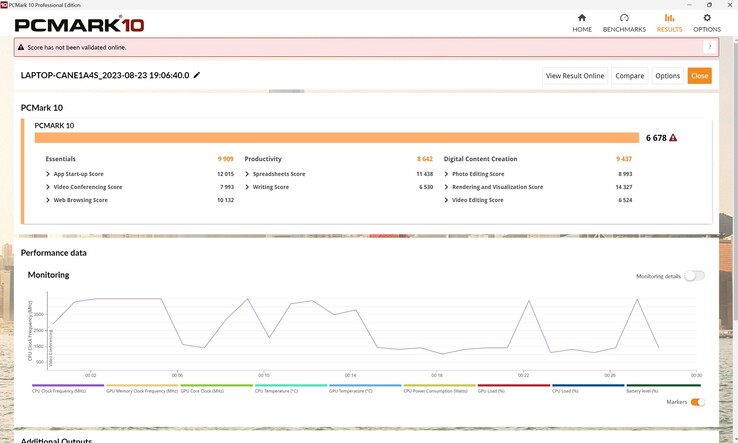 PCMark 10
PCMark 10
Lenovo Legion Slim 5 16APH8
NVIDIA GeForce RTX 4060 Laptop GPU, R7 7840HS, SK hynix PC801 HFS512GEJ9X115N
7946 Points ∼100% +19%
Asus TUF Gaming A16 FA617XS
Radeon RX 7600S, R9 7940HS, Micron 2400 MTFDKBA512QFM
7927 Points ∼100% +19%
Dell Inspiron 16 Plus 7630
NVIDIA GeForce RTX 4060 Laptop GPU, i7-13700H, WD PC SN740 SDDPTQD-1T00
7661 Points ∼96% +15%
Average of class Gaming
(4477 – 9331, n=196, last 2 years)
7408 Points ∼93% +11%
Captiva Advanced Gaming I74-121
NVIDIA GeForce RTX 4060 Laptop GPU, i5-13500H, Samsung SSD 980 1TB MZ-V8V1T0BW
7375 Points ∼93% +10%
Average Intel Core i7-13620H, NVIDIA GeForce RTX 4060 Laptop GPU
(6678 – 7160, n=2)
6919 Points ∼87% +4%
Acer Nitro 16 AN16-41-R7YE
NVIDIA GeForce RTX 4050 Laptop GPU, R5 7535HS, SK hynix HFS512GEJ9X125N
6690 Points ∼84% 0%
Lenovo LOQ 16IRH8
NVIDIA GeForce RTX 4060 Laptop GPU, i7-13620H, Solidigm SSDPFINW512GZL
6678 Points ∼84%
Captiva Advanced Gaming I74-121
NVIDIA GeForce RTX 4060 Laptop GPU, i5-13500H, Samsung SSD 980 1TB MZ-V8V1T0BW
11526 Points ∼100% +16%
Dell Inspiron 16 Plus 7630
NVIDIA GeForce RTX 4060 Laptop GPU, i7-13700H, WD PC SN740 SDDPTQD-1T00
11200 Points ∼97% +13%
Lenovo Legion Slim 5 16APH8
NVIDIA GeForce RTX 4060 Laptop GPU, R7 7840HS, SK hynix PC801 HFS512GEJ9X115N
11169 Points ∼97% +13%
Asus TUF Gaming A16 FA617XS
Radeon RX 7600S, R9 7940HS, Micron 2400 MTFDKBA512QFM
10844 Points ∼94% +9%
Average of class Gaming
(7334 – 12176, n=195, last 2 years)
10594 Points ∼92% +7%
Average Intel Core i7-13620H, NVIDIA GeForce RTX 4060 Laptop GPU
(9909 – 10809, n=2)
10359 Points ∼90% +5%
Lenovo LOQ 16IRH8
NVIDIA GeForce RTX 4060 Laptop GPU, i7-13620H, Solidigm SSDPFINW512GZL
9909 Points ∼86%
Acer Nitro 16 AN16-41-R7YE
NVIDIA GeForce RTX 4050 Laptop GPU, R5 7535HS, SK hynix HFS512GEJ9X125N
9736 Points ∼84% -2%
Asus TUF Gaming A16 FA617XS
Radeon RX 7600S, R9 7940HS, Micron 2400 MTFDKBA512QFM
10505 Points ∼100% +22%
Lenovo Legion Slim 5 16APH8
NVIDIA GeForce RTX 4060 Laptop GPU, R7 7840HS, SK hynix PC801 HFS512GEJ9X115N
10273 Points ∼98% +19%
Average of class Gaming
(6161 – 11833, n=195, last 2 years)
9576 Points ∼91% +11%
Dell Inspiron 16 Plus 7630
NVIDIA GeForce RTX 4060 Laptop GPU, i7-13700H, WD PC SN740 SDDPTQD-1T00
9394 Points ∼89% +9%
Captiva Advanced Gaming I74-121
NVIDIA GeForce RTX 4060 Laptop GPU, i5-13500H, Samsung SSD 980 1TB MZ-V8V1T0BW
9097 Points ∼87% +5%
Average Intel Core i7-13620H, NVIDIA GeForce RTX 4060 Laptop GPU
(8642 – 9308, n=2)
8975 Points ∼85% +4%
Lenovo LOQ 16IRH8
NVIDIA GeForce RTX 4060 Laptop GPU, i7-13620H, Solidigm SSDPFINW512GZL
8642 Points ∼82%
Acer Nitro 16 AN16-41-R7YE
NVIDIA GeForce RTX 4050 Laptop GPU, R5 7535HS, SK hynix HFS512GEJ9X125N
8167 Points ∼78% -5%
Asus TUF Gaming A16 FA617XS
Radeon RX 7600S, R9 7940HS, Micron 2400 MTFDKBA512QFM
11868 Points ∼100% +26%
Lenovo Legion Slim 5 16APH8
NVIDIA GeForce RTX 4060 Laptop GPU, R7 7840HS, SK hynix PC801 HFS512GEJ9X115N
11867 Points ∼100% +26%
Dell Inspiron 16 Plus 7630
NVIDIA GeForce RTX 4060 Laptop GPU, i7-13700H, WD PC SN740 SDDPTQD-1T00
11598 Points ∼98% +23%
Average of class Gaming
(5288 – 16424, n=195, last 2 years)
10948 Points ∼92% +16%
Captiva Advanced Gaming I74-121
NVIDIA GeForce RTX 4060 Laptop GPU, i5-13500H, Samsung SSD 980 1TB MZ-V8V1T0BW
10384 Points ∼87% +10%
Acer Nitro 16 AN16-41-R7YE
NVIDIA GeForce RTX 4050 Laptop GPU, R5 7535HS, SK hynix HFS512GEJ9X125N
10219 Points ∼86% +8%
Average Intel Core i7-13620H, NVIDIA GeForce RTX 4060 Laptop GPU
(9437 – 9903, n=2)
9670 Points ∼81% +2%
Lenovo LOQ 16IRH8
NVIDIA GeForce RTX 4060 Laptop GPU, i7-13620H, Solidigm SSDPFINW512GZL
9437 Points ∼80%
Lenovo LOQ 16IRH8
NVIDIA GeForce RTX 4060 Laptop GPU, i7-13620H, Solidigm SSDPFINW512GZL
1944 Points ∼100%
Average Intel Core i7-13620H, NVIDIA GeForce RTX 4060 Laptop GPU
(1857 – 1944, n=2)
1901 Points ∼98% -2%
Dell Inspiron 16 Plus 7630
NVIDIA GeForce RTX 4060 Laptop GPU, i7-13700H, WD PC SN740 SDDPTQD-1T00
1849 Points ∼95% -5%
Average of class Gaming
(974 – 2295, n=150, last 2 years)
1848 Points ∼95% -5%
Lenovo Legion Slim 5 16APH8
NVIDIA GeForce RTX 4060 Laptop GPU, R7 7840HS, SK hynix PC801 HFS512GEJ9X115N
1800 Points ∼93% -7%
Asus TUF Gaming A16 FA617XS
Radeon RX 7600S, R9 7940HS, Micron 2400 MTFDKBA512QFM
1774 Points ∼91% -9%
Captiva Advanced Gaming I74-121
NVIDIA GeForce RTX 4060 Laptop GPU, i5-13500H, Samsung SSD 980 1TB MZ-V8V1T0BW
1693 Points ∼87% -13%
Acer Nitro 16 AN16-41-R7YE
NVIDIA GeForce RTX 4050 Laptop GPU, R5 7535HS, SK hynix HFS512GEJ9X125N
1489 Points ∼77% -23%
Lenovo LOQ 16IRH8
NVIDIA GeForce RTX 4060 Laptop GPU, i7-13620H, Solidigm SSDPFINW512GZL
1869 Points ∼100%
Average Intel Core i7-13620H, NVIDIA GeForce RTX 4060 Laptop GPU
(1765 – 1869, n=2)
1817 Points ∼97% -3%
Average of class Gaming
(907 – 2166, n=150, last 2 years)
1767 Points ∼95% -5%
Lenovo Legion Slim 5 16APH8
NVIDIA GeForce RTX 4060 Laptop GPU, R7 7840HS, SK hynix PC801 HFS512GEJ9X115N
1743 Points ∼93% -7%
Dell Inspiron 16 Plus 7630
NVIDIA GeForce RTX 4060 Laptop GPU, i7-13700H, WD PC SN740 SDDPTQD-1T00
1743 Points ∼93% -7%
Asus TUF Gaming A16 FA617XS
Radeon RX 7600S, R9 7940HS, Micron 2400 MTFDKBA512QFM
1715 Points ∼92% -8%
Captiva Advanced Gaming I74-121
NVIDIA GeForce RTX 4060 Laptop GPU, i5-13500H, Samsung SSD 980 1TB MZ-V8V1T0BW
1672 Points ∼89% -11%
Acer Nitro 16 AN16-41-R7YE
NVIDIA GeForce RTX 4050 Laptop GPU, R5 7535HS, SK hynix HFS512GEJ9X125N
1494 Points ∼80% -20%
Dell Inspiron 16 Plus 7630
NVIDIA GeForce RTX 4060 Laptop GPU, i7-13700H, WD PC SN740 SDDPTQD-1T00
2064 Points ∼100% +1%
Lenovo LOQ 16IRH8
NVIDIA GeForce RTX 4060 Laptop GPU, i7-13620H, Solidigm SSDPFINW512GZL
2046 Points ∼99%
Average Intel Core i7-13620H, NVIDIA GeForce RTX 4060 Laptop GPU
(2013 – 2046, n=2)
2030 Points ∼98% -1%
Average of class Gaming
(1027 – 2514, n=150, last 2 years)
1997 Points ∼97% -2%
Asus TUF Gaming A16 FA617XS
Radeon RX 7600S, R9 7940HS, Micron 2400 MTFDKBA512QFM
1990 Points ∼96% -3%
Lenovo Legion Slim 5 16APH8
NVIDIA GeForce RTX 4060 Laptop GPU, R7 7840HS, SK hynix PC801 HFS512GEJ9X115N
1966 Points ∼95% -4%
Captiva Advanced Gaming I74-121
NVIDIA GeForce RTX 4060 Laptop GPU, i5-13500H, Samsung SSD 980 1TB MZ-V8V1T0BW
1740 Points ∼84% -15%
Acer Nitro 16 AN16-41-R7YE
NVIDIA GeForce RTX 4050 Laptop GPU, R5 7535HS, SK hynix HFS512GEJ9X125N
1538 Points ∼75% -25%
Lenovo LOQ 16IRH8
NVIDIA GeForce RTX 4060 Laptop GPU, i7-13620H, Solidigm SSDPFINW512GZL
1874 Points ∼100%
Average Intel Core i7-13620H, NVIDIA GeForce RTX 4060 Laptop GPU
(1734 – 1874, n=2)
1804 Points ∼96% -4%
Average of class Gaming
(1029 – 2275, n=150, last 2 years)
1690 Points ∼90% -10%
Captiva Advanced Gaming I74-121
NVIDIA GeForce RTX 4060 Laptop GPU, i5-13500H, Samsung SSD 980 1TB MZ-V8V1T0BW
1616 Points ∼86% -14%
Dell Inspiron 16 Plus 7630
NVIDIA GeForce RTX 4060 Laptop GPU, i7-13700H, WD PC SN740 SDDPTQD-1T00
1589 Points ∼85% -15%
Lenovo Legion Slim 5 16APH8
NVIDIA GeForce RTX 4060 Laptop GPU, R7 7840HS, SK hynix PC801 HFS512GEJ9X115N
1522 Points ∼81% -19%
Asus TUF Gaming A16 FA617XS
Radeon RX 7600S, R9 7940HS, Micron 2400 MTFDKBA512QFM
1388 Points ∼74% -26%
Acer Nitro 16 AN16-41-R7YE
NVIDIA GeForce RTX 4050 Laptop GPU, R5 7535HS, SK hynix HFS512GEJ9X125N
1342 Points ∼72% -28%
PCMark 10 Score
6678 points
Help
The LOQ 16 doesn’t have any problems opening the browser but only opening several browser tabs on our Homepage, and the LatencyMon tool notes the first latencies here.
Playing our 4K/60-fps YouTube videos, these are again increased. But at least, we cannot complain about any dropped frames. Prime95 doesn’t increase the latencies further. While the competitors have latency values that are similarly high, the LOQ 16 takes the unfortunate first place in this category.
Lenovo LOQ 16IRH8
NVIDIA GeForce RTX 4060 Laptop GPU, i7-13620H, Solidigm SSDPFINW512GZL
1397.1 μs * ∼100%
Asus TUF Gaming A16 FA617XS
Radeon RX 7600S, R9 7940HS, Micron 2400 MTFDKBA512QFM
1128.7 μs * ∼81% +19%
Captiva Advanced Gaming I74-121
NVIDIA GeForce RTX 4060 Laptop GPU, i5-13500H, Samsung SSD 980 1TB MZ-V8V1T0BW
1035.9 μs * ∼74% +26%
Lenovo Legion Slim 5 16APH8
NVIDIA GeForce RTX 4060 Laptop GPU, R7 7840HS, SK hynix PC801 HFS512GEJ9X115N
1027.3 μs * ∼74% +26%
Dell Inspiron 16 Plus 7630
NVIDIA GeForce RTX 4060 Laptop GPU, i7-13700H, WD PC SN740 SDDPTQD-1T00
1020.2 μs * ∼73% +27%
Acer Nitro 16 AN16-41-R7YE
NVIDIA GeForce RTX 4050 Laptop GPU, R5 7535HS, SK hynix HFS512GEJ9X125N
738.5 μs * ∼53% +47%
* … smaller is better
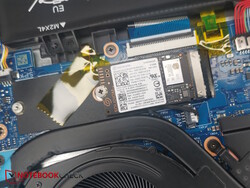 Small NVMe SSD
Small NVMe SSD
Lenovo uses a fairly unknown SSD with 512 GB of storage space in the small M.2 2230 form factor.
Even though there are faster storage modules available, particularly in comparison with the SSD in the Legion Slim 5, the performance is still okay here, especially considering that it remains constant over a longer time period.
CDM 5/6 Read Seq Q32T1:
3481 MB/s
CDM 5/6 Write Seq Q32T1:
1646 MB/s
CDM 5/6 Read 4K Q32T1:
460 MB/s
CDM 5/6 Write 4K Q32T1:
562 MB/s
CDM 5/6 Read 4K:
61.8 MB/s
CDM 5/6 Write 4K:
213 MB/s
CDM 6 Write 4K Q8T8:
1629 MB/s
CDM 6 Read 4K Q8T8:
472 MB/s
Lenovo Legion Slim 5 16APH8
SK hynix PC801 HFS512GEJ9X115N
3931 (3894.59min – 3931.22max) MB/s ∼100% +81%
Average of class Gaming
(1291 – 6045, n=196, last 2 years)
3359 MB/s ∼85% +55%
Dell Inspiron 16 Plus 7630
WD PC SN740 SDDPTQD-1T00
3156 (3078.2min – 3156.21max) MB/s ∼80% +45%
Acer Nitro 16 AN16-41-R7YE
SK hynix HFS512GEJ9X125N
2620 (2568.07min – 2619.97max) MB/s ∼67% +21%
Asus TUF Gaming A16 FA617XS
Micron 2400 MTFDKBA512QFM
2253 (2206.83min – 2252.55max) MB/s ∼57% +4%
Lenovo LOQ 16IRH8
Solidigm SSDPFINW512GZL
2171 (2026.48min – 2171.33max) MB/s ∼55%
Average Solidigm SSDPFINW512GZL
2171 MB/s ∼55% 0%
Captiva Advanced Gaming I74-121
Samsung SSD 980 1TB MZ-V8V1T0BW
1856 (1838.25min – 1855.56max) MB/s ∼47% -15%
Lenovo Legion Slim 5 16APH8
SK hynix PC801 HFS512GEJ9X115N
3639 (3528.67min – 3638.77max) MB/s ∼100% +122%
Average of class Gaming
(535 – 9108, n=196, last 2 years)
3552 MB/s ∼98% +117%
Dell Inspiron 16 Plus 7630
WD PC SN740 SDDPTQD-1T00
3503 (3341.99min – 3503.29max) MB/s ∼96% +114%
Captiva Advanced Gaming I74-121
Samsung SSD 980 1TB MZ-V8V1T0BW
2456 (2427.66min – 2456.3max) MB/s ∼67% +50%
Acer Nitro 16 AN16-41-R7YE
SK hynix HFS512GEJ9X125N
2430 (1756.94min – 2429.93max) MB/s ∼67% +48%
Asus TUF Gaming A16 FA617XS
Micron 2400 MTFDKBA512QFM
1671 (1641.02min – 1670.59max) MB/s ∼46% +2%
Lenovo LOQ 16IRH8
Solidigm SSDPFINW512GZL
1640 (1629.39min – 1639.55max) MB/s ∼45%
Average Solidigm SSDPFINW512GZL
1640 MB/s ∼45% 0%
Lenovo Legion Slim 5 16APH8
SK hynix PC801 HFS512GEJ9X115N
6625 (5896.09min – 6624.9max) MB/s ∼100% +89%
Average of class Gaming
(1620 – 16089, n=196, last 2 years)
5943 MB/s ∼90% +69%
Acer Nitro 16 AN16-41-R7YE
SK hynix HFS512GEJ9X125N
5729 (5328.06min – 5728.58max) MB/s ∼86% +63%
Dell Inspiron 16 Plus 7630
WD PC SN740 SDDPTQD-1T00
5187 (4478.95min – 5186.89max) MB/s ∼78% +48%
Asus TUF Gaming A16 FA617XS
Micron 2400 MTFDKBA512QFM
4294 (3669.6min – 4293.91max) MB/s ∼65% +22%
Captiva Advanced Gaming I74-121
Samsung SSD 980 1TB MZ-V8V1T0BW
3552 (2996.83min – 3551.74max) MB/s ∼54% +1%
Lenovo LOQ 16IRH8
Solidigm SSDPFINW512GZL
3507 (3153.28min – 3506.65max) MB/s ∼53%
Average Solidigm SSDPFINW512GZL
3507 MB/s ∼53% 0%
Lenovo Legion Slim 5 16APH8
SK hynix PC801 HFS512GEJ9X115N
4983 (3416.89min – 4982.83max) MB/s ∼100% +203%
Acer Nitro 16 AN16-41-R7YE
SK hynix HFS512GEJ9X125N
4958 (862.3min – 4957.61max) MB/s ∼99% +201%
Dell Inspiron 16 Plus 7630
WD PC SN740 SDDPTQD-1T00
4824 (4712.92min – 4824.08max) MB/s ∼97% +193%
Average of class Gaming
(86.2 – 14571, n=196, last 2 years)
4395 MB/s ∼88% +167%
Captiva Advanced Gaming I74-121
Samsung SSD 980 1TB MZ-V8V1T0BW
2717 (2695.32min – 2717.07max) MB/s ∼55% +65%
Asus TUF Gaming A16 FA617XS
Micron 2400 MTFDKBA512QFM
1773 (1734.23min – 1773.16max) MB/s ∼36% +8%
Lenovo LOQ 16IRH8
Solidigm SSDPFINW512GZL
1645 (1638.71min – 1645.22max) MB/s ∼33%
Average Solidigm SSDPFINW512GZL
1645 MB/s ∼33% 0%
Lenovo LOQ 16IRH8
Solidigm SSDPFINW512GZL
82.1 (81.04min – 82.14max) MB/s ∼100%
Average Solidigm SSDPFINW512GZL
82.1 MB/s ∼100% 0%
Dell Inspiron 16 Plus 7630
WD PC SN740 SDDPTQD-1T00
73.2 (70.67min – 73.2max) MB/s ∼89% -11%
Average of class Gaming
(30.6 – 97.4, n=196, last 2 years)
67.9 MB/s ∼83% -17%
Lenovo Legion Slim 5 16APH8
SK hynix PC801 HFS512GEJ9X115N
66.8 (66.2min – 66.77max) MB/s ∼81% -19%
Captiva Advanced Gaming I74-121
Samsung SSD 980 1TB MZ-V8V1T0BW
59.8 (58.67min – 59.75max) MB/s ∼73% -27%
Acer Nitro 16 AN16-41-R7YE
SK hynix HFS512GEJ9X125N
58.3 (57.69min – 58.29max) MB/s ∼71% -29%
Asus TUF Gaming A16 FA617XS
Micron 2400 MTFDKBA512QFM
32.8 (32.61min – 32.76max) MB/s ∼40% -60%
Lenovo LOQ 16IRH8
Solidigm SSDPFINW512GZL
288 (280.44min – 288.2max) MB/s ∼100%
Average Solidigm SSDPFINW512GZL
288 MB/s ∼100% 0%
Captiva Advanced Gaming I74-121
Samsung SSD 980 1TB MZ-V8V1T0BW
259 (254.62min – 258.51max) MB/s ∼90% -10%
Average of class Gaming
(66.6 – 421, n=196, last 2 years)
224 MB/s ∼78% -22%
Acer Nitro 16 AN16-41-R7YE
SK hynix HFS512GEJ9X125N
193.9 (190.37min – 193.9max) MB/s ∼67% -33%
Lenovo Legion Slim 5 16APH8
SK hynix PC801 HFS512GEJ9X115N
164.5 (161.01min – 164.51max) MB/s ∼57% -43%
Dell Inspiron 16 Plus 7630
WD PC SN740 SDDPTQD-1T00
158.8 (155.42min – 158.82max) MB/s ∼55% -45%
Asus TUF Gaming A16 FA617XS
Micron 2400 MTFDKBA512QFM
132 (125.41min – 131.99max) MB/s ∼46% -54%
Acer Nitro 16 AN16-41-R7YE
SK hynix HFS512GEJ9X125N
3789 (3765.64min – 3788.53max) MB/s ∼100% +693%
Average of class Gaming
(313 – 5870, n=196, last 2 years)
2449 MB/s ∼65% +412%
Captiva Advanced Gaming I74-121
Samsung SSD 980 1TB MZ-V8V1T0BW
2054 (2050.65min – 2054.43max) MB/s ∼54% +330%
Asus TUF Gaming A16 FA617XS
Micron 2400 MTFDKBA512QFM
1705 (1701.1min – 1704.63max) MB/s ∼45% +257%
Lenovo Legion Slim 5 16APH8
SK hynix PC801 HFS512GEJ9X115N
1064 (1053.8min – 1063.68max) MB/s ∼28% +123%
Dell Inspiron 16 Plus 7630
WD PC SN740 SDDPTQD-1T00
725 (704.24min – 724.66max) MB/s ∼19% +52%
Lenovo LOQ 16IRH8
Solidigm SSDPFINW512GZL
478 (473.67min – 477.66max) MB/s ∼13%
Average Solidigm SSDPFINW512GZL
478 MB/s ∼13% 0%
Average of class Gaming
(288 – 4869, n=196, last 2 years)
2089 MB/s ∼100% +28%
Captiva Advanced Gaming I74-121
Samsung SSD 980 1TB MZ-V8V1T0BW
1878 (1860.78min – 1877.62max) MB/s ∼90% +15%
Lenovo LOQ 16IRH8
Solidigm SSDPFINW512GZL
1631 (1609.28min – 1630.54max) MB/s ∼78%
Average Solidigm SSDPFINW512GZL
1631 MB/s ∼78% 0%
Asus TUF Gaming A16 FA617XS
Micron 2400 MTFDKBA512QFM
1585 (1554.44min – 1585.47max) MB/s ∼76% -3%
Acer Nitro 16 AN16-41-R7YE
SK hynix HFS512GEJ9X125N
1266 (1012.7min – 1266.22max) MB/s ∼61% -22%
Dell Inspiron 16 Plus 7630
WD PC SN740 SDDPTQD-1T00
513 (490.37min – 513.26max) MB/s ∼25% -69%
Lenovo Legion Slim 5 16APH8
SK hynix PC801 HFS512GEJ9X115N
489 (475.62min – 488.5max) MB/s ∼23% -70%
Average of class Gaming
(1923 – 10783, n=184, last 2 years)
6637 Points ∼100% +139%
Lenovo Legion Slim 5 16APH8
SK hynix PC801 HFS512GEJ9X115N
6188 Points ∼93% +122%
Acer Nitro 16 AN16-41-R7YE
SK hynix HFS512GEJ9X125N
5988 Points ∼90% +115%
Captiva Advanced Gaming I74-121
Samsung SSD 980 1TB MZ-V8V1T0BW
4891 Points ∼74% +76%
Dell Inspiron 16 Plus 7630
WD PC SN740 SDDPTQD-1T00
4383 Points ∼66% +58%
Asus TUF Gaming A16 FA617XS
Micron 2400 MTFDKBA512QFM
4261 Points ∼64% +53%
Lenovo LOQ 16IRH8
Solidigm SSDPFINW512GZL
2782 Points ∼42%
Average Solidigm SSDPFINW512GZL
2782 Points ∼42% 0%
Acer Nitro 16 AN16-41-R7YE
SK hynix HFS512GEJ9X125N
2860 Points ∼100% +269%
Average of class Gaming
(528 – 3980, n=184, last 2 years)
2454 Points ∼86% +216%
Captiva Advanced Gaming I74-121
Samsung SSD 980 1TB MZ-V8V1T0BW
2051 Points ∼72% +164%
Asus TUF Gaming A16 FA617XS
Micron 2400 MTFDKBA512QFM
1830 Points ∼64% +136%
Lenovo Legion Slim 5 16APH8
SK hynix PC801 HFS512GEJ9X115N
1599 Points ∼56% +106%
Dell Inspiron 16 Plus 7630
WD PC SN740 SDDPTQD-1T00
1459 Points ∼51% +88%
Lenovo LOQ 16IRH8
Solidigm SSDPFINW512GZL
776 Points ∼27%
Average Solidigm SSDPFINW512GZL
776 Points ∼27% 0%
Lenovo Legion Slim 5 16APH8
SK hynix PC801 HFS512GEJ9X115N
3884 Points ∼100% +136%
Average of class Gaming
(515 – 5339, n=184, last 2 years)
2987 Points ∼77% +82%
Dell Inspiron 16 Plus 7630
WD PC SN740 SDDPTQD-1T00
2233 Points ∼57% +36%
Acer Nitro 16 AN16-41-R7YE
SK hynix HFS512GEJ9X125N
1899 Points ∼49% +15%
Captiva Advanced Gaming I74-121
Samsung SSD 980 1TB MZ-V8V1T0BW
1770 Points ∼46% +8%
Lenovo LOQ 16IRH8
Solidigm SSDPFINW512GZL
1645 Points ∼42%
Average Solidigm SSDPFINW512GZL
1645 Points ∼42% 0%
Asus TUF Gaming A16 FA617XS
Micron 2400 MTFDKBA512QFM
1604 Points ∼41% -2%
Acer Nitro 16 AN16-41-R7YE
SK hynix HFS512GEJ9X125N
5449.25 MB/s ∼100% +109%
Lenovo Legion Slim 5 16APH8
SK hynix PC801 HFS512GEJ9X115N
5279.87 MB/s ∼97% +103%
Average of class Gaming
(1473 – 12763, n=184, last 2 years)
4634 MB/s ∼85% +78%
Dell Inspiron 16 Plus 7630
WD PC SN740 SDDPTQD-1T00
4349.04 MB/s ∼80% +67%
Asus TUF Gaming A16 FA617XS
Micron 2400 MTFDKBA512QFM
3690.93 MB/s ∼68% +42%
Lenovo LOQ 16IRH8
Solidigm SSDPFINW512GZL
2603 MB/s ∼48%
Average Solidigm SSDPFINW512GZL
2603 MB/s ∼48% 0%
Captiva Advanced Gaming I74-121
Samsung SSD 980 1TB MZ-V8V1T0BW
2260 MB/s ∼41% -13%
Average of class Gaming
(495 – 11316, n=184, last 2 years)
3358 MB/s ∼100% +135%
Dell Inspiron 16 Plus 7630
WD PC SN740 SDDPTQD-1T00
2904.62 MB/s ∼86% +104%
Lenovo Legion Slim 5 16APH8
SK hynix PC801 HFS512GEJ9X115N
2771.64 MB/s ∼83% +94%
Captiva Advanced Gaming I74-121
Samsung SSD 980 1TB MZ-V8V1T0BW
2477 MB/s ∼74% +74%
Asus TUF Gaming A16 FA617XS
Micron 2400 MTFDKBA512QFM
1633.49 MB/s ∼49% +14%
Lenovo LOQ 16IRH8
Solidigm SSDPFINW512GZL
1427 MB/s ∼42%
Average Solidigm SSDPFINW512GZL
1427 MB/s ∼42% 0%
Acer Nitro 16 AN16-41-R7YE
SK hynix HFS512GEJ9X125N
959.57 MB/s ∼29% -33%
Average of class Gaming
(28.8 – 112.1, n=184, last 2 years)
67.3 MB/s ∼100% +5%
Captiva Advanced Gaming I74-121
Samsung SSD 980 1TB MZ-V8V1T0BW
65.6 MB/s ∼97% +2%
Dell Inspiron 16 Plus 7630
WD PC SN740 SDDPTQD-1T00
65.43 MB/s ∼97% +2%
Lenovo LOQ 16IRH8
Solidigm SSDPFINW512GZL
64.4 MB/s ∼96%
Average Solidigm SSDPFINW512GZL
64.4 MB/s ∼96% 0%
Lenovo Legion Slim 5 16APH8
SK hynix PC801 HFS512GEJ9X115N
59.4 MB/s ∼88% -8%
Acer Nitro 16 AN16-41-R7YE
SK hynix HFS512GEJ9X125N
48.18 MB/s ∼72% -25%
Asus TUF Gaming A16 FA617XS
Micron 2400 MTFDKBA512QFM
42.75 MB/s ∼64% -34%
Lenovo LOQ 16IRH8
Solidigm SSDPFINW512GZL
237 MB/s ∼100%
Average Solidigm SSDPFINW512GZL
237 MB/s ∼100% 0%
Dell Inspiron 16 Plus 7630
WD PC SN740 SDDPTQD-1T00
225.06 MB/s ∼95% -5%
Captiva Advanced Gaming I74-121
Samsung SSD 980 1TB MZ-V8V1T0BW
222 MB/s ∼94% -6%
Average of class Gaming
(59 – 364, n=184, last 2 years)
206 MB/s ∼87% -13%
Lenovo Legion Slim 5 16APH8
SK hynix PC801 HFS512GEJ9X115N
198.51 MB/s ∼84% -16%
Acer Nitro 16 AN16-41-R7YE
SK hynix HFS512GEJ9X125N
150.14 MB/s ∼63% -37%
Asus TUF Gaming A16 FA617XS
Micron 2400 MTFDKBA512QFM
118.17 MB/s ∼50% -50%
Acer Nitro 16 AN16-41-R7YE
SK hynix HFS512GEJ9X125N
2216.52 MB/s ∼100% +391%
Average of class Gaming
(312 – 3395, n=184, last 2 years)
1922 MB/s ∼87% +326%
Captiva Advanced Gaming I74-121
Samsung SSD 980 1TB MZ-V8V1T0BW
1760 MB/s ∼79% +290%
Asus TUF Gaming A16 FA617XS
Micron 2400 MTFDKBA512QFM
1429.83 MB/s ∼65% +217%
Lenovo Legion Slim 5 16APH8
SK hynix PC801 HFS512GEJ9X115N
1011.42 MB/s ∼46% +124%
Dell Inspiron 16 Plus 7630
WD PC SN740 SDDPTQD-1T00
959.03 MB/s ∼43% +113%
Lenovo LOQ 16IRH8
Solidigm SSDPFINW512GZL
451 MB/s ∼20%
Average Solidigm SSDPFINW512GZL
451 MB/s ∼20% 0%
Lenovo Legion Slim 5 16APH8
SK hynix PC801 HFS512GEJ9X115N
3408.27 MB/s ∼100% +169%
Average of class Gaming
(277 – 4533, n=184, last 2 years)
2446 MB/s ∼72% +93%
Dell Inspiron 16 Plus 7630
WD PC SN740 SDDPTQD-1T00
1717.85 MB/s ∼50% +36%
Acer Nitro 16 AN16-41-R7YE
SK hynix HFS512GEJ9X125N
1652.79 MB/s ∼48% +31%
Asus TUF Gaming A16 FA617XS
Micron 2400 MTFDKBA512QFM
1411.25 MB/s ∼41% +12%
Captiva Advanced Gaming I74-121
Samsung SSD 980 1TB MZ-V8V1T0BW
1301 MB/s ∼38% +3%
Lenovo LOQ 16IRH8
Solidigm SSDPFINW512GZL
1265 MB/s ∼37%
Average Solidigm SSDPFINW512GZL
1265 MB/s ∼37% 0%
Captiva Advanced Gaming I74-121
Samsung SSD 980 1TB MZ-V8V1T0BW
0.077 ms * ∼100% -40%
Acer Nitro 16 AN16-41-R7YE
SK hynix HFS512GEJ9X125N
0.062 ms * ∼81% -13%
Asus TUF Gaming A16 FA617XS
Micron 2400 MTFDKBA512QFM
0.058 ms * ∼75% -5%
Dell Inspiron 16 Plus 7630
WD PC SN740 SDDPTQD-1T00
0.057 ms * ∼74% -4%
Lenovo LOQ 16IRH8
Solidigm SSDPFINW512GZL
0.055 ms * ∼71%
Average Solidigm SSDPFINW512GZL
0.055 ms * ∼71% -0%
Average of class Gaming
(0.02 – 0.163, n=182, last 2 years)
0.05192 ms * ∼67% +6%
Lenovo Legion Slim 5 16APH8
SK hynix PC801 HFS512GEJ9X115N
0.05 ms * ∼65% +9%
Asus TUF Gaming A16 FA617XS
Micron 2400 MTFDKBA512QFM
0.118 ms * ∼100% -228%
Dell Inspiron 16 Plus 7630
WD PC SN740 SDDPTQD-1T00
0.07 ms * ∼59% -94%
Lenovo Legion Slim 5 16APH8
SK hynix PC801 HFS512GEJ9X115N
0.057 ms * ∼48% -58%
Average of class Gaming
(0.011 – 1.028, n=184, last 2 years)
0.05395 ms * ∼46% -50%
Lenovo LOQ 16IRH8
Solidigm SSDPFINW512GZL
0.036 ms * ∼31%
Average Solidigm SSDPFINW512GZL
0.036 ms * ∼31% -0%
Acer Nitro 16 AN16-41-R7YE
SK hynix HFS512GEJ9X125N
0.026 ms * ∼22% +28%
Captiva Advanced Gaming I74-121
Samsung SSD 980 1TB MZ-V8V1T0BW
0.017 ms * ∼14% +53%
* … smaller is better
034569010351380172520702415276031053450379541404485483051755520586562106555Tooltip
You have the choice between an RTX 4050 and an RTX 4060. Our test unit uses the latter, and it is allowed to consume a maximum of 115 W including Dynamic Boost, which is not much. For example, the same GPU is allowed to consume 140 W in the Captiva Advanced Gaming.
However, the GPU in the LOQ 16 is still able to do what it needs to do, or even more than that. Compared to the competitors, it reaches second place in the 3DMarks behind the Captiva.
Captiva Advanced Gaming I74-121
NVIDIA GeForce RTX 4060 Laptop GPU, Intel Core i5-13500H
180228 Points ∼100% +25%
Acer Nitro 16 AN16-41-R7YE
NVIDIA GeForce RTX 4050 Laptop GPU, AMD Ryzen 5 7535HS
161152 Points ∼89% +12%
Asus TUF Gaming A16 FA617XS
AMD Radeon RX 7600S, AMD Ryzen 9 7940HS
155806 Points ∼86% +8%
Average NVIDIA GeForce RTX 4060 Laptop GPU
(81407 – 180228, n=18)
145940 Points ∼81% +2%
Lenovo LOQ 16IRH8
NVIDIA GeForce RTX 4060 Laptop GPU, Intel Core i7-13620H
143621 Points ∼80%
Average of class Gaming
(15902 – 193851, n=158, last 2 years)
130868 Points ∼73% -9%
Average of class Gaming
(781 – 53059, n=240, last 2 years)
27773 Points ∼100% +6%
Captiva Advanced Gaming I74-121
NVIDIA GeForce RTX 4060 Laptop GPU, Intel Core i5-13500H
27752 Points ∼100% +6%
Asus TUF Gaming A16 FA617XS
AMD Radeon RX 7600S, AMD Ryzen 9 7940HS
26154 Points ∼94% 0%
Lenovo LOQ 16IRH8
NVIDIA GeForce RTX 4060 Laptop GPU, Intel Core i7-13620H
26079 Points ∼94%
Average NVIDIA GeForce RTX 4060 Laptop GPU
(20533 – 27752, n=24)
25201 Points ∼91% -3%
Lenovo Legion Slim 5 16APH8
NVIDIA GeForce RTX 4060 Laptop GPU, AMD Ryzen 7 7840HS
23418 Points ∼84% -10%
Acer Nitro 16 AN16-41-R7YE
NVIDIA GeForce RTX 4050 Laptop GPU, AMD Ryzen 5 7535HS
23204 Points ∼84% -11%
Dell Inspiron 16 Plus 7630
NVIDIA GeForce RTX 4060 Laptop GPU, Intel Core i7-13700H
21600 Points ∼78% -17%
Average of class Gaming
(224 – 22547, n=240, last 2 years)
11077 Points ∼100% +7%
Captiva Advanced Gaming I74-121
NVIDIA GeForce RTX 4060 Laptop GPU, Intel Core i5-13500H
10417 Points ∼94% 0%
Lenovo LOQ 16IRH8
NVIDIA GeForce RTX 4060 Laptop GPU, Intel Core i7-13620H
10366 Points ∼94%
Average NVIDIA GeForce RTX 4060 Laptop GPU
(7484 – 10855, n=24)
9708 Points ∼88% -6%
Asus TUF Gaming A16 FA617XS
AMD Radeon RX 7600S, AMD Ryzen 9 7940HS
9203 Points ∼83% -11%
Lenovo Legion Slim 5 16APH8
NVIDIA GeForce RTX 4060 Laptop GPU, AMD Ryzen 7 7840HS
8873 Points ∼80% -14%
Acer Nitro 16 AN16-41-R7YE
NVIDIA GeForce RTX 4050 Laptop GPU, AMD Ryzen 5 7535HS
8363 Points ∼75% -19%
Dell Inspiron 16 Plus 7630
NVIDIA GeForce RTX 4060 Laptop GPU, Intel Core i7-13700H
7877 Points ∼71% -24%
3DMark 11 Performance
30250 points3DMark Cloud Gate Standard Score
56287 points3DMark Fire Strike Score
22013 points3DMark Time Spy Score
10608 points
Help
Dell Inspiron 16 Plus 7630
NVIDIA GeForce RTX 4060 Laptop GPU, Intel Core i7-13700H
27 Seconds * ∼100% -23%
Acer Nitro 16 AN16-41-R7YE
NVIDIA GeForce RTX 4050 Laptop GPU, AMD Ryzen 5 7535HS
26 Seconds * ∼96% -18%
Average of class Gaming
(9 – 142, n=130, last 2 years)
23.7 Seconds * ∼88% -8%
Average NVIDIA GeForce RTX 4060 Laptop GPU
(19 – 28, n=22)
23.6 Seconds * ∼87% -7%
Captiva Advanced Gaming I74-121
NVIDIA GeForce RTX 4060 Laptop GPU, Intel Core i5-13500H
23 Seconds * ∼85% -5%
Lenovo Legion Slim 5 16APH8
NVIDIA GeForce RTX 4060 Laptop GPU, AMD Ryzen 7 7840HS
22 Seconds * ∼81% -0%
Lenovo LOQ 16IRH8
NVIDIA GeForce RTX 4060 Laptop GPU, Intel Core i7-13620H
22 Seconds * ∼81%
Average NVIDIA GeForce RTX 4060 Laptop GPU
(40 – 208, n=23)
51.5 Seconds * ∼100% -23%
Acer Nitro 16 AN16-41-R7YE
NVIDIA GeForce RTX 4050 Laptop GPU, AMD Ryzen 5 7535HS
50 Seconds * ∼97% -19%
Dell Inspiron 16 Plus 7630
NVIDIA GeForce RTX 4060 Laptop GPU, Intel Core i7-13700H
49 Seconds * ∼95% -17%
Lenovo Legion Slim 5 16APH8
NVIDIA GeForce RTX 4060 Laptop GPU, AMD Ryzen 7 7840HS
44 Seconds * ∼85% -5%
Lenovo LOQ 16IRH8
NVIDIA GeForce RTX 4060 Laptop GPU, Intel Core i7-13620H
42 Seconds * ∼82%
Captiva Advanced Gaming I74-121
NVIDIA GeForce RTX 4060 Laptop GPU, Intel Core i5-13500H
42 Seconds * ∼82% -0%
Average of class Gaming
(17 – 178, n=134, last 2 years)
41.2 Seconds * ∼80% +2%
Acer Nitro 16 AN16-41-R7YE
NVIDIA GeForce RTX 4050 Laptop GPU, AMD Ryzen 5 7535HS
481 Seconds * ∼100% -23%
Dell Inspiron 16 Plus 7630
NVIDIA GeForce RTX 4060 Laptop GPU, Intel Core i7-13700H
400 Seconds * ∼83% -2%
Lenovo LOQ 16IRH8
NVIDIA GeForce RTX 4060 Laptop GPU, Intel Core i7-13620H
391 Seconds * ∼81%
Captiva Advanced Gaming I74-121
NVIDIA GeForce RTX 4060 Laptop GPU, Intel Core i5-13500H
348 Seconds * ∼72% +11%
Average of class Gaming
(144 – 907, n=145, last 2 years)
322 Seconds * ∼67% +18%
Average NVIDIA GeForce RTX 4060 Laptop GPU
(189 – 435, n=22)
315 Seconds * ∼65% +19%
Asus TUF Gaming A16 FA617XS
AMD Radeon RX 7600S, AMD Ryzen 9 7940HS
301 Seconds * ∼63% +23%
Lenovo Legion Slim 5 16APH8
NVIDIA GeForce RTX 4060 Laptop GPU, AMD Ryzen 7 7840HS
298 Seconds * ∼62% +24%
* … smaller is better
When gaming, the LOQ 16 does an even better job, surpassing even the Captiva with its 140-W RTX-4060 and just barely reaching first place. Even the more expensive Legion Slim 5 is beaten by about 14%.
The gaming performance is not impacted negatively at all by the affordable price of the LOQ 16. Current games should run smoothly in Full-HD resolution even using the highest quality settings, and in parts this also goes for the native QHD resolution.
Captiva Advanced Gaming I74-121
Intel Core i5-13500H, NVIDIA GeForce RTX 4060 Laptop GPU
117 (8.04min, 76.9P1) fps ∼100% +2%
Lenovo LOQ 16IRH8
Intel Core i7-13620H, NVIDIA GeForce RTX 4060 Laptop GPU
114.5 (8.64min, 76.9P1) fps ∼98%
Average of class Gaming
(6.38 – 167.7, n=224, last 2 years)
101.9 fps ∼87% -11%
Lenovo Legion Slim 5 16APH8
AMD Ryzen 7 7840HS, NVIDIA GeForce RTX 4060 Laptop GPU
101 (5.12min, 71.4P1) fps ∼86% -12%
Asus TUF Gaming A16 FA617XS
AMD Ryzen 9 7940HS, AMD Radeon RX 7600S
92.9 (26.7min, 62.5P1) fps ∼79% -19%
Captiva Advanced Gaming I74-121
Intel Core i5-13500H, NVIDIA GeForce RTX 4060 Laptop GPU
187.9 (125.1min, 137.8P1) fps ∼100% +1%
Average of class Gaming
(13.8 – 421, n=233, last 2 years)
187.9 fps ∼100% +1%
Lenovo LOQ 16IRH8
Intel Core i7-13620H, NVIDIA GeForce RTX 4060 Laptop GPU
186.9 (46.3min, 136.1P1) fps ∼99%
Lenovo Legion Slim 5 16APH8
AMD Ryzen 7 7840HS, NVIDIA GeForce RTX 4060 Laptop GPU
168.2 (38.3min, 126.4P1) fps ∼90% -10%
Asus TUF Gaming A16 FA617XS
AMD Ryzen 9 7940HS, AMD Radeon RX 7600S
163.3 (16.3min, 119.3P1) fps ∼87% -13%
Dell Inspiron 16 Plus 7630
Intel Core i7-13700H, NVIDIA GeForce RTX 4060 Laptop GPU
161 (79.8min, 120.7P1) fps ∼86% -14%
Acer Nitro 16 AN16-41-R7YE
AMD Ryzen 5 7535HS, NVIDIA GeForce RTX 4050 Laptop GPU
146.8 (93.6min, 114.3P1) fps ∼78% -21%
Average of class Gaming
(17.5 – 449, n=177, last 2 years)
199.2 fps ∼100% +2%
Captiva Advanced Gaming I74-121
Intel Core i5-13500H, NVIDIA GeForce RTX 4060 Laptop GPU
199 fps ∼100% +2%
Lenovo LOQ 16IRH8
Intel Core i7-13620H, NVIDIA GeForce RTX 4060 Laptop GPU
195.3 fps ∼98%
Average NVIDIA GeForce RTX 4060 Laptop GPU
(112 – 216, n=22)
186.3 fps ∼94% -5%
Lenovo Legion Slim 5 16APH8
AMD Ryzen 7 7840HS, NVIDIA GeForce RTX 4060 Laptop GPU
180.2 (167min) fps ∼90% -8%
Dell Inspiron 16 Plus 7630
Intel Core i7-13700H, NVIDIA GeForce RTX 4060 Laptop GPU
169.5 (158min) fps ∼85% -13%
Asus TUF Gaming A16 FA617XS
AMD Ryzen 9 7940HS, AMD Radeon RX 7600S
166.5 (140min) fps ∼84% -15%
Acer Nitro 16 AN16-41-R7YE
AMD Ryzen 5 7535HS, NVIDIA GeForce RTX 4050 Laptop GPU
156.2 (136min) fps ∼78% -20%
Average of class Gaming
(8.61 – 216, n=235, last 2 years)
107.2 fps ∼100% +3%
Lenovo LOQ 16IRH8
Intel Core i7-13620H, NVIDIA GeForce RTX 4060 Laptop GPU
103.7 fps ∼97%
Average NVIDIA GeForce RTX 4060 Laptop GPU
(77 – 159.7, n=25)
102.1 fps ∼95% -2%
Captiva Advanced Gaming I74-121
Intel Core i5-13500H, NVIDIA GeForce RTX 4060 Laptop GPU
101 fps ∼94% -3%
Asus TUF Gaming A16 FA617XS
AMD Ryzen 9 7940HS, AMD Radeon RX 7600S
98.1 (84min) fps ∼92% -5%
Lenovo Legion Slim 5 16APH8
AMD Ryzen 7 7840HS, NVIDIA GeForce RTX 4060 Laptop GPU
93.2 (87min) fps ∼87% -10%
Dell Inspiron 16 Plus 7630
Intel Core i7-13700H, NVIDIA GeForce RTX 4060 Laptop GPU
90.9 (85min) fps ∼85% -12%
Acer Nitro 16 AN16-41-R7YE
AMD Ryzen 5 7535HS, NVIDIA GeForce RTX 4050 Laptop GPU
83.9 (71min) fps ∼78% -19%
Captiva Advanced Gaming I74-121
Intel Core i5-13500H, NVIDIA GeForce RTX 4060 Laptop GPU
147 fps ∼100% +3%
Lenovo LOQ 16IRH8
Intel Core i7-13620H, NVIDIA GeForce RTX 4060 Laptop GPU
143 fps ∼97%
Average NVIDIA GeForce RTX 4060 Laptop GPU
(104 – 155, n=15)
133.7 fps ∼91% -7%
Average of class Gaming
(16 – 232, n=128, last 2 years)
127.7 fps ∼87% -11%
Asus TUF Gaming A16 FA617XS
AMD Ryzen 9 7940HS, AMD Radeon RX 7600S
115 (88min) fps ∼78% -20%
Dell Inspiron 16 Plus 7630
Intel Core i7-13700H, NVIDIA GeForce RTX 4060 Laptop GPU
115 (74min) fps ∼78% -20%
Acer Nitro 16 AN16-41-R7YE
AMD Ryzen 5 7535HS, NVIDIA GeForce RTX 4050 Laptop GPU
108 (82min) fps ∼73% -24%
Captiva Advanced Gaming I74-121
Intel Core i5-13500H, NVIDIA GeForce RTX 4060 Laptop GPU
138 fps ∼100% +4%
Lenovo LOQ 16IRH8
Intel Core i7-13620H, NVIDIA GeForce RTX 4060 Laptop GPU
133 fps ∼96%
Average NVIDIA GeForce RTX 4060 Laptop GPU
(95 – 146, n=16)
125.7 fps ∼91% -5%
Average of class Gaming
(14 – 218, n=136, last 2 years)
120 fps ∼87% -10%
Asus TUF Gaming A16 FA617XS
AMD Ryzen 9 7940HS, AMD Radeon RX 7600S
108 (77min) fps ∼78% -19%
Dell Inspiron 16 Plus 7630
Intel Core i7-13700H, NVIDIA GeForce RTX 4060 Laptop GPU
103 (74min) fps ∼75% -23%
Acer Nitro 16 AN16-41-R7YE
AMD Ryzen 5 7535HS, NVIDIA GeForce RTX 4050 Laptop GPU
102 (70min) fps ∼74% -23%
Average of class Gaming
(12.8 – 186.5, n=20, last 2 years)
93.9 fps ∼100% +24%
Average NVIDIA GeForce RTX 4060 Laptop GPU
(70.8 – 107.7, n=6)
85.2 fps ∼91% +13%
Lenovo LOQ 16IRH8
Intel Core i7-13620H, NVIDIA GeForce RTX 4060 Laptop GPU
75.7 fps ∼81%
Asus TUF Gaming A16 FA617XS
AMD Ryzen 9 7940HS, AMD Radeon RX 7600S
72 (35.4min, 42.2P0.1, 52.4P1) fps ∼77% -5%
Average of class Gaming
(10.3 – 166.1, n=20, last 2 years)
78.6 fps ∼100% +27%
Average NVIDIA GeForce RTX 4060 Laptop GPU
(61.9 – 91.9, n=6)
72.8 fps ∼93% +18%
Lenovo LOQ 16IRH8
Intel Core i7-13620H, NVIDIA GeForce RTX 4060 Laptop GPU
61.9 fps ∼79%
Asus TUF Gaming A16 FA617XS
AMD Ryzen 9 7940HS, AMD Radeon RX 7600S
55.4 (27min, 28.2P0.1, 39P1) fps ∼70% -11%
The frame rate of The Witcher 3 remains very constant across one hour, only showing the usual day/night variations during the game.
The TDP of the CPU lies at 35 W on average, and it reaches a temperature of about 75 °C (167 °F).
In Balanced Mode, the GPU clock speed decreases continuously during the hour, but the total drop is only 100 MHz, from 2.4 to 2.3 GHz. The temperatures increase continuously up to 72 °C (162 °F) in the end. The average TGP that is reached is 80 W.
In Quiet Mode, the GPU clock speeds starts only slightly higher than 2 GHz but also doesn’t drop to any value below that. At the same time, the temperature only increase to 65 °C (149 °F), with a TGP of about 45 W. However, the noise level is significantly lower, as you can see in the table below:
Power Mode
GPU Clock Speed (MHz)
Temperature
Power Consumption
Average FPS
Noise Level
Quiet Mode
2,050
up to 65 °C (149 °F)
45 W
83 fps
37.29 dB
Balanced Mode
2,340
up to 72 °C (162 °F)
80 W
91 fps
46.81 dB
Performance Mode
2,475
up to 78 °C (172 °F)
95 W
95 fps
53.50 dB
0102030405060708090100Tooltip
During idle operation, the fans often – but not always – remain quiet. Under load, the fan behavior is less than optimal. Already in 3DMark 06, the fans roar at full volume toward the end of the run, and they won’t even get louder during the hour-long stress test. Other laptops do a better job here, producing less than the maximum noise level under average load.
However, the maximum noise level isn’t unusually high, and aside from the quieter Acer Nitro 16, the competitors produce a similar maximum noise level. The difference is that they stay quieter longer.
Noise Level
Idle
23 / 23 / 27.66 dB(A)
Load
53.62 / 53.5 dB(A)

30 dB
silent
40 dB(A)
audible
50 dB(A)
loud
min: ![]() , med:
, med: ![]() , max:
, max: ![]() Earthworks M23R, Arta (15 cm distance) environment noise: 23 dB(A)
Earthworks M23R, Arta (15 cm distance) environment noise: 23 dB(A)
dB(A)
0102030405060708090Deep BassMiddle BassHigh BassLower RangeMidsHigher MidsLower HighsMid HighsUpper HighsSuper Highs2031.127.731.1253127.9313134.23134.24024.120.824.15022.118.722.16324.119.724.18022.515.822.510025.12125.112523.611.923.616024.912.124.92002920.1292503113.43131529.88.929.840033.87.933.850034.37.634.363036.9836.980039.68.139.6100038.98.238.9125043.18.543.1160042.99.542.9200039.710.139.7250040.210.640.2315040.511.240.5400042.411.742.4500042.111.842.1630038.712.238.7800034.812.734.81000031.812.631.81250027.212.227.21600022.51322.5SPL52.32352.3N8.10.48.1median 34.8median 11.7median 34.8Delta6.226.23839.441.640.738.231.629.735.632.53124.826.126.328.126.227.52725.227.12726.92723.324.124.128.223.524.726.323.725.525.323.227.926.123.622.622.222.725.425.620.420.722.324.823.920.315.517.324.325.421.114.915.925.72819.815.417.627.83120.31414.530.429.52211.813.130.131.524.211.311.63132.620.610.910.232.437.121.89.59.537.438.2239.3938.540.224.59.49.340.640.524.29.69.540.140.223.79.99.740.740.62510.310.240.340.327.210.710.640.241.122.111.11141.244.817.911.611.445.342.618.11211.842.738.615.912.111.738.735.51511.711.635.432.114.411.711.732.128.512.911.111.32852.335.123.123.252.57.92.10.50.58median 35.5median 21.1median 11.6median 11.6median 35.46.22.922.86.2hearing rangehide median Fan NoiseLenovo LOQ 16IRH8Dell Inspiron 16 Plus 7630
Lenovo LOQ 16IRH8
NVIDIA GeForce RTX 4060 Laptop GPU, i7-13620H, Solidigm SSDPFINW512GZLDell Inspiron 16 Plus 7630
NVIDIA GeForce RTX 4060 Laptop GPU, i7-13700H, WD PC SN740 SDDPTQD-1T00Acer Nitro 16 AN16-41-R7YE
NVIDIA GeForce RTX 4050 Laptop GPU, R5 7535HS, SK hynix HFS512GEJ9X125NCaptiva Advanced Gaming I74-121
NVIDIA GeForce RTX 4060 Laptop GPU, i5-13500H, Samsung SSD 980 1TB MZ-V8V1T0BWLenovo Legion Slim 5 16APH8
NVIDIA GeForce RTX 4060 Laptop GPU, R7 7840HS, SK hynix PC801 HFS512GEJ9X115NAsus TUF Gaming A16 FA617XS
Radeon RX 7600S, R9 7940HS, Micron 2400 MTFDKBA512QFMoff / environment *
23
23.2
-1%
24
-4%
23
-0%
22.9
-0%
25
-9%
Idle Minimum *
23
23.2
-1%
25
-9%
23
-0%
23.1
-0%
25
-9%
Idle Average *
23
23.2
-1%
26
-13%
25.67
-12%
23.1
-0%
26
-13%
Idle Maximum *
27.66
23.2
16%
27
2%
25.67
7%
27.7
-0%
28
-1%
Load Average *
53.62
35.1
35%
42
22%
38.52
28%
33.3
38%
43
20%
Witcher 3 ultra *
53.5
52.5
2%
43
20%
54.17
-1%
54
-1%
51
5%
Load Maximum *
53.5
52.5
2%
45
16%
54.17
-1%
54
-1%
53
1%
* … smaller is better
The hottest place in the LOQ 16 is at the bottom, where we measure almost 60 °C (140 °F) during the stress test in the central area toward the display. The top stays at least 10 degrees cooler (up to 122 °F). The hotspots are also in the center toward the display here. The WASD keys get less hot at up to 40 °C (104 °F), while the palm rests stay cool.
42 °C
108 F45 °C
113 F37 °C
99 F 44 °C
111 F48 °C
118 F39 °C
102 F 30 °C
86 F27 °C
81 F25 °C
77 F
Maximum: 48 °C=118 F
Average: 37.4 °C=99 F
48 °C
118 F59 °C
138 F47 °C
117 F42 °C
108 F55 °C
131 F49 °C
120 F24 °C
75 F24 °C
75 F25 °C
77 F
Maximum: 59 °C=138 F
Average: 41.4 °C=107 F
Power Supply (max.) 47 °C=117 F | Room Temperature 22 °C=72 F | Fluke t3000FC (calibrated),Fluke 62 Mini
(±) The average temperature for the upper side under maximal load is 37.4 °C / 99 F, compared to the average of 33.9 °C / 93 F for the devices in the class Gaming.
(-) The maximum temperature on the upper side is 48 °C / 118 F, compared to the average of 40.4 °C / 105 F, ranging from 21.2 to 68.8 °C for the class Gaming.
(-) The bottom heats up to a maximum of 59 °C / 138 F, compared to the average of 43.2 °C / 110 F
(+) In idle usage, the average temperature for the upper side is 25.6 °C / 78 F, compared to the device average of 33.9 °C / 93 F.
(±) Playing The Witcher 3, the average temperature for the upper side is 37.3 °C / 99 F, compared to the device average of 33.9 °C / 93 F.
(+) The palmrests and touchpad are cooler than skin temperature with a maximum of 31 °C / 87.8 F and are therefore cool to the touch.
(±) The average temperature of the palmrest area of similar devices was 29 °C / 84.2 F (-2 °C / -3.6 F).
The CPU cores begin the hour-long stress test with Prime95 and Furmark running simultaneously briefly with a clock speed above 4 GHz. After about 30 seconds, the clock speed drops, before leveling out at 2,300 MHz after about 3 minutes. At the same time, the TDP drops from 135 to a finally constant 45 W. The CPU heats up to about 80 ºC (176 ºF).
On the other hand, the GPU clock speed remains at a relatively constant 2,200 MHz over the whole test period, and the storage speed is 2 GHz. During this time, the GPU heats up to a maximum of 84 ºC (183 ºF). The power consumption is 87 W on average.
CPU Clock (MHz)
GPU Clock (MHz)
Average CPU Temperature (°C)
Average GPU Temperature (°C)
Prime95 + FurMark Stress
2,300
2,200
80
84
The Witcher 3 Stress
540
2,475
75
78
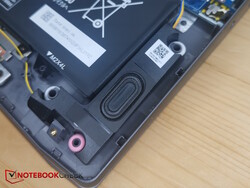 The speakers on the sides in front point toward the bottom
The speakers on the sides in front point toward the bottom
The speakers suffer from the usual symptoms of affordable laptop models: too quiet, hardly any bass, and the highs are the only frequencies you can only call linear and balanced.
A solution is to connect headphones or other external audio devices via the combined audio port, among other options.
dB(A)
0102030405060708090Deep BassMiddle BassHigh BassLower RangeMidsHigher MidsLower HighsMid HighsUpper HighsSuper Highs2033.73133.72530.631.830.63138.637.238.64028.629.728.65028.82728.86325.621.825.6802317.62310025.618.325.612533.112.933.116043.411.243.420048.815.548.825050.513.150.531550.89.950.840050.58.550.5500578.45763066.57.266.580070.97.870.9100072.98.572.9125074.18.674.1160074.29.374.2200071.49.971.4250067.710.767.7315066.51166.5400062.211.362.2500060.811.660.8630055.211.755.2800054.611.854.61000056.111.856.11250057.211.757.21600051.31151.3SPL81.322.681.3N43.40.443.4median 57median 11median 57Delta8.51.78.537.83532.233.742.140.434.844.921.824.324.522.625.423.716.927.214.724.115.230.419.141.414.856.213.16110.466.211.769.111.371.510.772.210.771.910.969.51170.611.368.412.167.412.166.712.466.512.463.512.56912.874.812.576.412.168.211.872.624.182.30.555.5median 12.1median 68.21.77.5hearing rangehide median Pink NoiseLenovo LOQ 16IRH8Acer Nitro 16 AN16-41-R7YE
Frequency diagram (checkboxes can be checked and unchecked to compare devices)
Lenovo LOQ 16IRH8 audio analysis
(±) | speaker loudness is average but good (81.33 dB)
Bass 100 – 315 Hz
(-) | nearly no bass – on average 15% lower than median
(±) | linearity of bass is average (10% delta to prev. frequency)
Mids 400 – 2000 Hz
(±) | higher mids – on average 11.8% higher than median
(±) | linearity of mids is average (7.3% delta to prev. frequency)
Highs 2 – 16 kHz
(+) | balanced highs – only 4.9% away from median
(+) | highs are linear (5.7% delta to prev. frequency)
Overall 100 – 16.000 Hz
(±) | linearity of overall sound is average (22.8% difference to median)
Compared to same class
» 79% of all tested devices in this class were better, 6% similar, 16% worse
» The best had a delta of 7%, average was 19%, worst was 132%
Compared to all devices tested
» 61% of all tested devices were better, 6% similar, 33% worse
» The best had a delta of 4%, average was 26%, worst was 134%
Acer Nitro 16 AN16-41-R7YE audio analysis
(+) | speakers can play relatively loud (82 dB)
Bass 100 – 315 Hz
(-) | nearly no bass – on average 28.2% lower than median
(±) | linearity of bass is average (12.9% delta to prev. frequency)
Mids 400 – 2000 Hz
(+) | balanced mids – only 2.2% away from median
(+) | mids are linear (3.8% delta to prev. frequency)
Highs 2 – 16 kHz
(+) | balanced highs – only 3.5% away from median
(+) | highs are linear (4.6% delta to prev. frequency)
Overall 100 – 16.000 Hz
(±) | linearity of overall sound is average (17.3% difference to median)
Compared to same class
» 43% of all tested devices in this class were better, 11% similar, 46% worse
» The best had a delta of 7%, average was 19%, worst was 132%
Compared to all devices tested
» 26% of all tested devices were better, 8% similar, 67% worse
» The best had a delta of 4%, average was 26%, worst was 134%
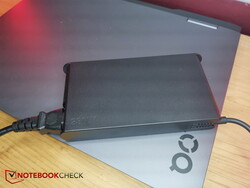 The 230-W power supply from Lenovo
The 230-W power supply from Lenovo
The LOQ 16 isn’t an efficient laptop and particularly during idle operation, the consumption is too high. Under load, the consumption is appropriate considering the performance.
With a similar performance, the Captiva consumes just as much power, and likewise the Asus TUF. During gaming, the Dell Inspiron 16, the Acer Nitro 16, and the Legion Slim 5 consume significantly less power, but they also have a lower 3D performance.
We measure a temporary maximum peak of 211 W, which the included 230-W power supply has no trouble handling.
Lenovo LOQ 16IRH8
i7-13620H, NVIDIA GeForce RTX 4060 Laptop GPU, Solidigm SSDPFINW512GZL, IPS, 2560×1600, 16.00Dell Inspiron 16 Plus 7630
i7-13700H, NVIDIA GeForce RTX 4060 Laptop GPU, WD PC SN740 SDDPTQD-1T00, IPS, 2560×1600, 16.00Acer Nitro 16 AN16-41-R7YE
R5 7535HS, NVIDIA GeForce RTX 4050 Laptop GPU, SK hynix HFS512GEJ9X125N, IPS, 1920×1200, 16.00Captiva Advanced Gaming I74-121
i5-13500H, NVIDIA GeForce RTX 4060 Laptop GPU, Samsung SSD 980 1TB MZ-V8V1T0BW, IPS, 1920×1080, 15.60Lenovo Legion Slim 5 16APH8
R7 7840HS, NVIDIA GeForce RTX 4060 Laptop GPU, SK hynix PC801 HFS512GEJ9X115N, IPS, 2560×1600, 16.00Asus TUF Gaming A16 FA617XS
R9 7940HS, Radeon RX 7600S, Micron 2400 MTFDKBA512QFM, IPS, 1920×1200, 16.00Average NVIDIA GeForce RTX 4060 Laptop GPU
Average of class Gaming
Idle Minimum *
17.2
15.6
9%
19
-10%
18.4
-7%
9.4
45%
7
59%
12.3 ?(6 – 24.5, n=23)
28%
13.7 ?(3 – 64, n=186, last 2 years)
20%
Idle Average *
19.3
17.7
8%
20
-4%
20
-4%
15.5
20%
10
48%
16.4 ?(8.8 – 29.2, n=23)
15%
18.7 ?(6.5 – 68.2, n=186, last 2 years)
3%
Idle Maximum *
21.2
20.6
3%
23
-8%
20.7
2%
24.4
-15%
15
29%
20.7 ?(11.9 – 42.7, n=23)
2%
25.8 ?(8.9 – 76, n=185, last 2 years)
-22%
Load Average *
90
87.4
3%
80
11%
85
6%
74.1
18%
86
4%
96.6 ?(59.3 – 190, n=23)
-7%
112.1 ?(32.1 – 202, n=186, last 2 years)
-25%
Witcher 3 ultra *
168
121.7
28%
125.8
25%
164
2%
112.9
33%
160.6
4%
Load Maximum *
211
138
35%
184
13%
219
-4%
206.5
2%
172
18%
216 ?(99 – 364, n=23)
-2%
245 ?(64.5 – 418, n=185, last 2 years)
-16%
* … smaller is better
0153045607590105120135150165180195210225Tooltip
Lenovo LOQ 16IRH8 i7-13620H, NVIDIA GeForce RTX 4060 Laptop GPU; Witcher 3 ultra: Ø169 (127.61-225.97)
Dell Inspiron 16 Plus 7630 i7-13700H, NVIDIA GeForce RTX 4060 Laptop GPU; Witcher 3 ultra: Ø121.7 (116-127.6)
Lenovo LOQ 16IRH8 i7-13620H, NVIDIA GeForce RTX 4060 Laptop GPU; 1280×720 Prime95 28.10 and Furmark 1.25: Ø181.7 (91.34-210.51)
Dell Inspiron 16 Plus 7630 i7-13700H, NVIDIA GeForce RTX 4060 Laptop GPU; 1280×720 Prime95 28.10 and Furmark 1.25: Ø120.3 (102.4-138)
Captiva Advanced Gaming I74-121 i5-13500H, NVIDIA GeForce RTX 4060 Laptop GPU; 1280×720 Prime95 28.10 and Furmark 1.25: Ø179.2 (106.29-218.76)
Lenovo LOQ 16IRH8 i7-13620H, NVIDIA GeForce RTX 4060 Laptop GPU; Idle 150cd/m2: Ø17.7 (11.614-36.746)
Dell Inspiron 16 Plus 7630 i7-13700H, NVIDIA GeForce RTX 4060 Laptop GPU; Idle 150cd/m2: Ø17.1 (16.2-22.9)
0102030405060708090100110120130140150160170180190Tooltip
Lenovo LOQ 16IRH8 i7-13620H, NVIDIA GeForce RTX 4060 Laptop GPU; Prime95 V2810 Stress (external Monitor): Ø134.9 (113.2-193.22)
Dell Inspiron 16 Plus 7630 i7-13700H, NVIDIA GeForce RTX 4060 Laptop GPU; Prime95 V2810 Stress (external Monitor): Ø82.1 (62.2-138)
Lenovo LOQ 16IRH8 i7-13620H, NVIDIA GeForce RTX 4060 Laptop GPU; Cinebench R15 Multi (external Monitor): Ø170.4 (161.42-184.2)
Dell Inspiron 16 Plus 7630 i7-13700H, NVIDIA GeForce RTX 4060 Laptop GPU; Cinebench R15 Multi (external Monitor): Ø119.9 (110.7-133.4)
Lenovo LOQ 16IRH8 i7-13620H, NVIDIA GeForce RTX 4060 Laptop GPU; Cinebench R23 Multi (external Monitor): Ø114.3 (66.76-183.45)
Lenovo LOQ 16IRH8 i7-13620H, NVIDIA GeForce RTX 4060 Laptop GPU; 1280×720 FurMark 1.19 GPU Stress Test (external Monitor): Ø156.2 (147.38-160.57)
Dell Inspiron 16 Plus 7630 i7-13700H, NVIDIA GeForce RTX 4060 Laptop GPU; 1280×720 FurMark 1.19 GPU Stress Test (external Monitor): Ø103.6 (98.1-126.3)
Lenovo LOQ 16IRH8 i7-13620H, NVIDIA GeForce RTX 4060 Laptop GPU; 1920×1080 The Witcher 3 ultra (external Monitor): Ø158.2 (150.28-166.33)
Dell Inspiron 16 Plus 7630 i7-13700H, NVIDIA GeForce RTX 4060 Laptop GPU; 1920×1080 The Witcher 3 ultra (external Monitor): Ø120.7 (116.9-127.8)
Lenovo LOQ 16IRH8 i7-13620H, NVIDIA GeForce RTX 4060 Laptop GPU; Idle 1min (external Monitor): Ø19.7 (9.776-66.66)
Dell Inspiron 16 Plus 7630 i7-13700H, NVIDIA GeForce RTX 4060 Laptop GPU; Idle 1min (external Monitor): Ø16.3 (14.3-26.2)
Our test unit contains a battery with a 80 Wh capacity, but Lenovo also uses a battery with only 60 Wh capacity, so you have to be careful. In the configurator, the larger battery costs only a few Euros more.
With the larger battery, the LOQ lasts more than 6 hours in our Wi-Fi and video tests at an adjusted brightness. At full display brightness, it only lasts for 5.5 hours. This is surprisingly short, since some of the competitors with similarly large batteries last significantly longer. Only the Legion Slim 5 is similarly weak. Apparently, the power saving mechanisms aren’t perfect with Lenovo yet. Particularly the idle consumption still needs to be lower. Perhaps the overloaded Control Center that we complained about earlier has a part in this.
Battery Runtime
WiFi Websurfing
6h 16min
WiFi Websurfing max. Brightness
5h 25min
Big Buck Bunny H.264 1080p
6h 25min
Load (maximum brightness)
1h 28min
Lenovo LOQ 16IRH8
i7-13620H, NVIDIA GeForce RTX 4060 Laptop GPU, 80 WhDell Inspiron 16 Plus 7630
i7-13700H, NVIDIA GeForce RTX 4060 Laptop GPU, 86 WhAcer Nitro 16 AN16-41-R7YE
R5 7535HS, NVIDIA GeForce RTX 4050 Laptop GPU, 90 WhCaptiva Advanced Gaming I74-121
i5-13500H, NVIDIA GeForce RTX 4060 Laptop GPU, 53 WhLenovo Legion Slim 5 16APH8
R7 7840HS, NVIDIA GeForce RTX 4060 Laptop GPU, 80 WhAsus TUF Gaming A16 FA617XS
R9 7940HS, Radeon RX 7600S, 90 WhAverage of class Gaming
H.264
385
650
69%
296
-23%
746
94%
380 ?(56 – 747, n=99, last 2 years)
-1%
WiFi v1.3
376
566
51%
660
76%
315
-16%
425
13%
745
98%
362 ?(57 – 745, n=182, last 2 years)
-4%
Load
88
85
-3%
134
52%
96
9%
70
-20%
52
-41%
86.1 ?(36 – 228, n=153, last 2 years)
-2%
Reader / Idle
1055
721
699
1217
541 ?(57 – 1217, n=90, last 2 years)
Pros
+ webcam shutter
+ good maintenance options
+ solid and fast 16:10 QHD display with sRGB
+ many manual performance options in the Control Center
+ powerful 3D performance despite only using 115 W
Cons
– relatively large and heavy
– no Thunderbolt, no SD card reader
– rather slow Wi-Fi
– Control Center is loaded with ads
– quickly reaches maximum noise level
– below average runtimes despite the large battery
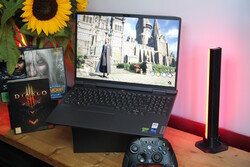 The Lenovo LOQ 16, test unit provided by Cyberport
The Lenovo LOQ 16, test unit provided by Cyberport
Gaming laptops with an RTX 4060 are available starting from about 1,000 Euros (~$1,060), even in 16-inch format. For the supposedly affordable Lenovo LOQ 16 (1,500 Euros, ~$1,591), the manufacturer particularly saves in the equipment and materials compared to the more expensive Legion series. In addition, the LOQ is slightly heavier and more bulky.
What remains is anything but a laptop full of difficult compromises. Instead, this is a more than solid gaming laptop that focusses on the 3D performance. While the QHD display is also able to keep up with the Legion series, the Full-HD version is less able to do that.
The fan behavior and battery life give reasons for complaint: The fans quickly start roaring at maximum noise level even under average load. And despite the fairly large battery, we only get below average runtimes. Perhaps Lenovo should get rid of the advertisings in its Control Center and preinstall less bloatware.
The Lenovo LOQ 16 with QHD display is a capable and relatively affordable gaming laptop that hardly lacks anything in this price range, but that still needs some optimizations of the battery, the fan behavior, or the Control Center.
Some alternatives are also available: The Dell Inspiron 16 Plus 7630 costs just as much, and even though the performance is slightly lower, it is more efficient and offers a longer battery life and a 1,600p display. The slightly more affordable Acer Nitro 16 is also slightly slower, but shines with a good battery life and its display supports G-Sync.
Lenovo LOQ 16IRH8
–
09/27/2023 v7
Christian Hintze
Pointing Device
80 / 10-66 → 100%
Games Performance
99 / 90 → 100%
Application Performance
92%
Gaming – Weighted Average
Transparency
The present review sample was made available to the author as a loan by the manufacturer or a shop for the purposes of review. The lender had no influence on this review, nor did the manufacturer receive a copy of this review before publication. There was no obligation to publish this review.

A C64 marked my entry into the world of PCs. I spent my student internship in the repair department of a computer shop and at the end of the day I was allowed to assemble my own 486 PC from “workshop remnants”. As a result of this, I later studied computer science at the Humboldt University in Berlin, with psychology also being added to my studies. After my first job as a research assistant at the university, I went to London for a year and worked for Sega in computer game translation quality assurance. This included working on games such as Sonic & All-Stars Racing Transformed and Company of Heroes. I have been writing for Notebookcheck since 2017.

Translator: Mark Riege – Translator – 466 articles published on Notebookcheck since 2018
Having worked as a programmer for 20 years (medical devices, AI, data management systems), I’ve been following the computer scene for many years and especially enjoy finding out about new technology advances. Originally from Germany but living in the US, I’ve been working as a translator more recently, with Notebookcheck allowing me to combine my interest in new devices and translation. Other interests include Buddhism, spending time in Tibetan monasteries, and translating ancient Tibetan texts.
Christian Hintze, 2023-09-30 (Update: 2023-09-30)
>>> Read full article>>>
Copyright for syndicated content belongs to the linked Source : NotebookCheck – https://www.notebookcheck.net/Lenovo-LOQ-16-gaming-laptop-review-Where-is-the-hitch-compared-to-the-more-expensive-Legion.756532.0.html































